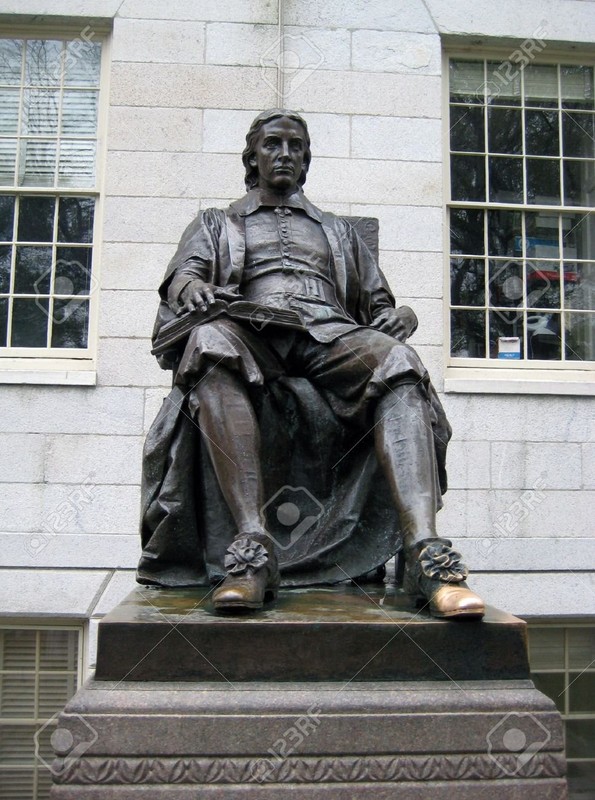John Harvard Statue
Introduction
Author-Uploaded Audio
00:00 / 00:00
Listen to a narration of this entry's description by Victoria Endres.
Text-to-speech Audio
Images

Backstory and Context
Author-Uploaded Audio
00:00 / 00:00
Listen to a narration of this entry's description by Victoria Endres.
Text-to-speech Audio
The John Harvard statue was sculpted between 1883-1884 by a Daniel Chester French, a Harvard College graduate. Nicknamed the “Statue of Three Lies,” there are many inaccuracies revolving the statue and the man it depicts, John Harvard.
John Harvard was born in London and in the early part of his life became one of the Puritan colonists to immigrate to and colonize New England in 1636. In the New World, Harvard was able to serve as the assistant pastor of the First Church of Charlestown due to his religious training at the University of Cambridge and Emmanuel College, both in Cambridge, England. As months past in New England, he was recognized as a pious upholder of Puritan values. He was well-known in Charlestown and the Massachusetts Bay Colony. This relative fame, as well as an inheritance in England in Europe, resulted in him being wealthy.
Harvard died from tuberculosis in 1638, after being in the New Word for less than a year. However, he left about 1600 pounds of his wealth as well as a collection of theological and classical works to a nearby school, New College, established in 1636 and dedicated to the pursuit of theology. After Harvard’s donation, the school renamed itself as Harvard College to remember its first large donation.
To remember Harvard, two monuments were created. One was a large granite monument located in Phipps Burial Ground, Charleston, and the other was a bronze statue of a man sitting in a chair, located in Harvard Yard. The statue’s pedestal holds a plaque that says “John Harvard – Founder – 1638.” However, this inscription is where the statue gets the nickname “Statue of Three Lies.” The model that was used for the sculpting was not John Harvard, but a student at Harvard College named Sherman Hoar. Second, Harvard had not donated to the college until his death, but by that time, the school was already two years old. While he was their first important benefactor, he was not involved in the school’s creation. Third, the school wasn’t founded in 1638, but rather in 1636. A superstition surrounding the statue is that students rub the left shoe’s toe for luck. This has caused many tourists to rub the statue’s toe, but it is not actually a student tradition.
While these inaccuracies cause amusement among many today, at the time of dedication the attention was focussed on a debate about the likeness of Harvard being modeled on Sherman Hoar. French, the sculptor, was applauded by some for using Hoar for the model, because French claimed that Hoar “has more of what I wanted” than anyone else in terms of facial structure. The people who supported French believed that the statue must be as ideal and as perfect as possible, and without Harvard’s actual facial features, Hoar was a suitable replacement. However, others criticized the representation, claiming that this false representation was worse than no representation. Regardless of the debate regarding the statue, the monument itself is an important part of the Harvard Yard and a way to remember the man whose donation allowed a newly made school to become one of the most prestigious in the country.
Cite This Entry
Boston University et. al. "John Harvard Statue." Clio: Your Guide to History. November 1, 2020. Accessed April 11, 2025. https://theclio.com/entry/68930
Sources
America's Library. Clergyman John Harvard Died September 14, 1638. Library of Congress. . Accessed November 28, 2018. http://www.americaslibrary.gov/jb/colonial/jb_colonial_harvard_1.html.
The Editors of Encyclopaedia Britannica. “John Harvard.” Encyclopædia Britannica, Encyclopædia Britannica, Inc., 28 Oct. 2018, www.britannica.com/biography/John-Harvard.
Harvard family. The John Harvard family collection, 1577, 1622, and 1828-2007. HUG 1447, Harvard University Archives. http://id.lib.harvard.edu/ead/hua05007/catalog Accessed November 28, 2018
“History: About: Harvard at a Glance.” Harvard College, The President and Fellows of Harvard College, 2018, www.harvard.edu/about-harvard/harvard-glance/history.
“John Harvard Statue.” Cambridge Historical Tours, FareHarbor, cambridgehistoricaltours.org/about-us/sites/john-harvard-statue/.
Melnick, Arseny James, and Julie Melnick. “The Life and Times of John Harvard.” The Life and Times of John Harvard, Harvard University, 1977, 2007, www.johnharvard.us/.
Shelley, Henry Charles. John Harvard and His Times. Boston, MA. Little, Brown, 1907.
Wright, Conrad Edick. "John Harvard." Harvard Magazine. 1996. Harvard Magazine. .

